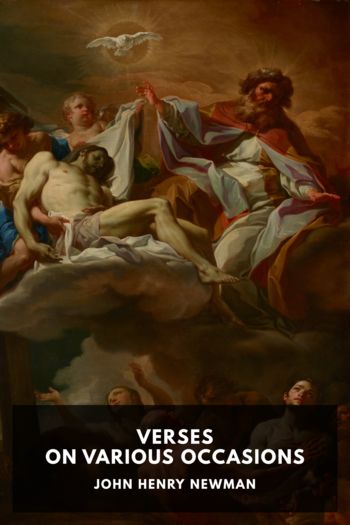Don Quixote, Miguel de Cervantes Saavedra [reading well .txt] 📗

- Author: Miguel de Cervantes Saavedra
Book online «Don Quixote, Miguel de Cervantes Saavedra [reading well .txt] 📗». Author Miguel de Cervantes Saavedra
In the Morgante Maggiore of Pulci. The account of the bones found in Sicily is in the Jardín de Flores Curiosos of Antonio de Torquemada, “the Spanish Mandeville,” as his English translator calls him. ↩
The friend was his master, Dardinel, beside whose body he received the wound of which he was cured by Angelica. ↩
Cervantes misquotes Ariosto’s lines, which are:
“E dell’ India a Medor desse lo scettro,
Forse altri canterà con miglior plettro.”
↩
The Andalusian was Barahona de Soto, who wrote the Primera Parte de la Angelica (not Lagrimas de Angelica, as Cervantes calls it in Part I Chapter VI). It appeared at Granada in 1586. The Castilian was Lope de Vega, whose Hermosura de Angelica formed the first part of his Rimas, printed at Madrid in 1602. ↩
In the original insulas ni insulos. Insula, the word always used in the Amadís, and by Don Quixote, instead of isla, is a puzzle to the niece and housekeeper. ↩
I.e., the gentry by birth and the gentry by position. ↩
In the time of Cervantes the title of Don was much more restricted than nowadays, when it is by courtesy given to everyone. ↩
Literally, “with a rag behind and another in front.” ↩
Alluding to the proverb (111) Hidalgo honrado antes roto que remendado—“The gentleman of honour, ragged sooner than patched.” ↩
Proverb 52, meaning “don’t fancy you have done with it.” ↩
Proverbial phrase 229. ↩
Berengena—the aubergine or eggplant. ↩
The critics and commentators have been much troubled by the inconsistency involved in making only a month elapse between the termination of the First Part and the resumption of the story, in which short space of time the first volume is supposed to have been written, translated, printed, and circulated, as we are afterwards told, to the extent of 12,000 copies. Cervantes, however, himself saw the blunder, as we perceive here, and makes a happy use of it as evidence of enchantment in the knight’s eyes. Cervantes never troubled his head about such inconsistencies. The action of the whole story of Don Quixote is supposed to extend over three or four months only, but according to dates it extends over twenty-five years, from 1589 to 1614. ↩
No edition appeared at Barcelona in the lifetime of Cervantes, and no edition of the First Part by itself was ever printed at Antwerp. On the other hand, there were two editions at Brussels and one at Milan, of which Cervantes does not seem to have been aware when he wrote this. ↩
Si se anda á decir verdades. ↩
Proverb 220—Aun hay sol en las barbas, i.e. “the day is not yet over. Las bardas are properly not the wall itself, but a kind of coping of straw or faggots laid along the top of it. ↩
In the original, Grama-tica—grama being an instrument for dressing flax, and therefore quite within Sancho’s comprehension. ↩
Revolver berzas con capachos is, according to Covarrubias, a familiar phrase to express jumbling together things of different sorts. ↩
In the original, trillada, “thrashed,” as wheat is in Spain, by having the trilla, a sort of harrow, dragged over it. ↩
Proverb 166. In full it runs, “with straw or with hay the mattress is filled.” ↩
El Tostado was Alonso de Madrigal, Bishop of Avila, a prolific author of devotional works in the reign of John II. ↩
Proverb 128. ↩
This passage has somewhat puzzled those who were unaware of the difference in text between the first and the subsequent editions. Cervantes is here speaking of the first edition, in which (as has been already pointed out, Part I Chapter XXIII) no account of the theft of the ass is given. From this we gather that Cervantes himself had nothing to do with the attempt made in the second edition to rectify the blunder, for had it been his own work he certainly would not have ignored it as he does here. ↩
He is here ridiculing what he considers the hypercriticism of those readers who make a fuss about such trifling slips. ↩
A slang phrase for being weak for want of food. ↩
Equivalent to our phrase, “stay and take potluck.” ↩
“La sella su qnattro aste gli suffolse,
E di sotto il destrier nudo gli tolse.”
But the idea was Boiardo’s:
“E la cingia disciolse presto presto,
E pose il legno sotto de lo arcione.”
It seems plain from this that Cervantes meant to introduce into the First Part a burlesque of the theft of Sacripante’s horse, with Ginés de Pasamonte playing the part of Brunello. It would have been an incident exactly in the spirit of the book. ↩
Proverb 80. ↩
Ripio, small stones and mortar used in building to fill the interstices between the large stones. ↩
In commemoration of the battle of Alcoraz, where in 1096 Pedro I of Aragón, with the help of St. George, defeated the Moors. ↩
The old Spanish war-cry,





Comments (0)